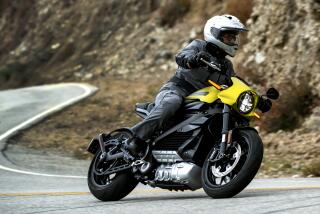The Search for a Practical Battery : Energy: Auto makers, utilities, battery makers and the federal government to jointly develop a cheap, durable power source for non-polluting electric cars.
- Share via
The Big Three auto makers are forming a Manhattan Project-style research consortium with utilities, battery makers and the federal government to develop a cheap, durable battery capable of powering the non-polluting electric cars of the future, officials said Friday.
The lack of such a battery is the most important technological impediment to a practical electric vehicle, said Roberta J. Nichols, a manager in Ford Motor Co.’s alternative fuels department.
Electric vehicles are now believed to be the only type of car that will meet state requirements for zero emissions in 1998.
They could also cut reliance on imported oil, since utility officials estimate there is already ample spare electric generating capacity to energize an armada of them during the off-peak hours when most would be recharged.
Nothing has been formalized, but in meetings in the last two months, General Motors Corp., Ford Motor Co. and Chrysler Corp. have neared agreement with Southern California Edison Co., the Energy Department and others on a consortium to develop a workable battery system that would be shared by all. The nonprofit Electric Power Research Institute, or EPRI, a utility industry-financed research group, would also take part.
The 12-year project is expected to come together by spring and will cost “in the tens of millions of dollars,” said Richard Schweinberg, manager of electric transportation at Edison.
Up until now, the auto makers, utilities and battery makers have all pursued independent--and sometimes competing--research into battery systems, and dozens of technologies have been considered. The alternatives developed so far all have serious drawbacks.
“Unless we have this concentrated effort on a few batteries and increase funding significantly, . . . it will take a very long time to have commercially available batteries,” Schweinberg said.
“It’s like going to the moon,” added Francois J. Castaing, Chrysler’s vice president of vehicle engineering. “If you decide you’re going to go, you have to spend money together to get there.” Officials said they did not expect antitrust objections to the consortium.
The proposed project is one sign of auto makers’ stepped up efforts to develop so-called alternative fuel vehicles for commercial production, now that it is clear that clean-air laws will require them to introduce such vehicles within the decade.
Starting in 1998, the California Air Resources Board will require 2% of each car manufacturer’s production, or a total of roughly 40,000 vehicles a year, to produce no emissions. By 2003, that percentage rises to 10%, or a total of about 200,000 vehicles a year.
News of the joint project emerged during press briefings at the Greater Los Angeles Auto Show, opening today at the Los Angeles Convention Center, where several auto makers will display prototype electric and alternative fuel vehicles to stimulate consumer awareness.
On Friday, Chrysler’s Castaing said the auto maker would begin a 28-month engineering and development study, in conjunction with EPRI, to bring its prototype electric minivan into commercial production. The TE Van, powered by a nickel-iron battery, would be aimed at fleet markets in California, for use as a delivery vehicle in downtown areas.
Similarly, Ford’s Nichols said Thursday that Ford has moved beyond the research stage and is now studying possible commercial production of an electric van.
A prototype electric Aerostar van, powered by a heated sodium sulfur battery, has already been developed with help from General Electric Co. and the Energy Department.
WHAT POWERS THEM The main types of battery technology currently used in prototype electric vehicles:
Lead-acid batteries, comparable to the ones in the family car, are cheap and easy to make. But they are heavy, have limited capacity and short life spans.
Sodium-sulfur batteries can store more energy than lead acid, but operate at high temperatures (more than 500 degrees Fahrenheit).
Nickel-iron batteries are light and durable, but nickel is very expensive.






